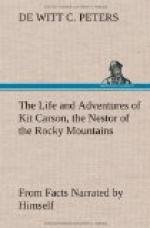Besides the many dangers to his flock which a person runs the risk of, both from the numerous accidents to which it is liable, and the unwelcome visits of the Indians when thus traveling, there are others which may occasionally happen to his own person. He may be, while standing guard, suddenly attacked and bitten by a mad wolf. On this event occurring, he is almost certain to be seized with that terrible, and we might as well add incurable disease, hydrophobia, which renders him a most pitiful object to behold. From a human being so recently respected and beloved by his companions, a person, thus unfortunate, is suddenly changed into an object most dreaded and detested. A party of Mexicans in charge of a large herd of sheep, a few years since, were bound to California. One night a large, ferocious wolf entered the camp, and bit a man in the leg. Symptoms of hydrophobia very soon set in, and in a short time the victim was a confirmed case of the disease. His comrades had no proper means of taking care of and transporting him, as they were hundreds of miles from the nearest house. They were superstitious, and believed that all would die if they kept the man’s company any longer; accordingly, they drove a stake in the ground, to which they inhumanly secured him; and, after depositing a small allowance of provisions near by, they left him to die. Human bones were afterwards found near the identical spot where it was said this unfortunate incident happened, which afforded strong circumstantial evidence that the man had eked out a miserable existence soon after he was deserted by his so-called friends, and also, that the truth of this story rested upon strong probability.
When the Americans first obtained possession of New Mexico, sheep could be bought at the rate of twenty-five cents per head. The reason of this was, the want of a market and the ease with which they were raised. Cheapness of labor, also, assisted in reducing their value. The wool of these sheep was rather coarse, resembling hair more than wool. The only use in which it was employed, was for manufacturing blankets, rough carpet, and in filling mattresses. The valley of the Rio Grande is wonderful as a sheep growing country. The mountain districts also cannot be excelled in this respect. Their fitness for grazing is best exemplified by their abounding in the famous Rocky Mountain sheep. In many respects this animal resembles the chamois. They live on the tops of the highest peaks, eat the tenderest grass, and produce the finest flavored mutton in the world. One of their heads, with the horns, often weighs one hundred pounds. To shoot them, requires all of an experienced hunter’s skill, and, when he has brought down one of these trophies, he feels he has done more than if he had killed ten deer. The sight of one of these mountain sheep, as perched on a high, rocky peak, is beautiful. The hostile Indians are the main drawback in New Mexico, to the successful raising of sheep.




